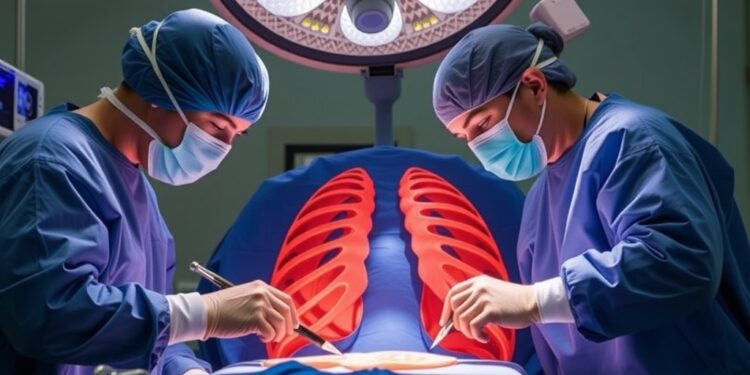On January 27, 2025, the release of DeepSeek, a groundbreaking open-source large language model (LLM), marked a pivotal moment in artificial intelligence’s evolution, especially in the realm of natural language processing (NLP). Built on a foundation of advanced machine learning techniques, DeepSeek has positioned itself as an alternative that rivals existing proprietary models, such as those developed by OpenAI. In an era where the potential of AI has been widely recognized, DeepSeek’s introduction raises the expectations of what can be achieved in various professional fields, making it particularly relevant for the medical community.
In the medical field, prior to the arrival of DeepSeek, specialized AI applications had already begun transforming practices. Thoracic surgery has particularly embraced AI technologies, leveraging machine learning and deep learning advancements. For instance, AI-driven tools have been utilized in preoperative planning, intraoperative assistance, and postoperative analysis, demonstrating their capacity to enhance surgical outcomes and improve diagnostic accuracy. With historical imaging data often insufficient for certain diagnoses, AI’s ability to interpret these results has surpassed human analysis in some instances, paving the way for greater reliance on technology in clinical settings.
However, the transition into this new era is not without challenges. The economic implications of adopting and implementing AI technologies have raised significant concerns, especially in resource-strapped environments. Hospitals and healthcare facilities often grapple with the financial burden of integrating sophisticated AI solutions like DeepSeek. Additionally, concerns regarding the quality of datasets used to train AI models are paramount. Many AI systems are developed from narrow datasets, leading to overfitting, which can degrade their effectiveness when applied to broader, real-world clinical scenarios.
Despite these challenges, DeepSeek offers compelling advantages. Its capacity for extensive reasoning, derived from open-source principles, distinguishes it from its closed-source counterparts. This transparency allows medical professionals to validate and scrutinize DeepSeek’s recommendations, thus integrating its insights more confidently into their clinical decision-making processes. The model’s ability to access vast medical databases ensures that it remains aligned with the latest research advancements, bolstering its reliability. In emergencies, such as diagnosing rapidly deteriorating conditions, DeepSeek can quicken the decision-making process, significantly impacting the care of critically ill patients.
Beyond decision-making, DeepSeek’s capabilities extend into the operational arena of thoracic surgeries. The potential for AI to assist in identifying tumor boundaries pre-operatively allows surgeons to execute procedures with increased precision. By employing augmented reality (AR) and virtual reality (VR) technology, DeepSeek facilitates better visibility of complex anatomical structures, simplifying intricate surgical maneuvers. This technology becomes particularly essential in segmentectomy procedures for early-stage non-small cell lung cancer (NSCLC), where precise anatomical delineation is crucial.
Nevertheless, while AI’s role in thoracic surgery is expanding, it is important to remember that it is not a substitute for surgeon expertise. The nuances of medical decision-making require human oversight, as empathy and moral judgment are integral to patient care—qualities that AI lacks. Even though DeepSeek enhances workflows and patient outcomes, its function is to complement rather than replace the essential human touch in medicine.
Additionally, the implications of DeepSeek are significant for medical research. The AI’s ability to process large quantities of data means that literature review and analysis can be accelerated. Researchers can leverage DeepSeek to overcome linguistic barriers, quickly identifying pertinent studies in foreign publications and gaining insights into current research trends. As a result, DeepSeek streamlines the development of meta-analyses and systematic reviews, allowing researchers to concentrate on substantive scientific inquiries rather than getting bogged down by extensive administrative tasks.
The transition toward what is termed “intelligent surgery” signals the evolution of surgical practices in thoracic medicine. Robot-assisted thoracic surgery (RATS) is already shifting paradigms in surgical techniques, and by integrating DeepSeek, the potential for refined workflows becomes a reality. In this context, AI can quickly assimilate data from surgical procedures, creating a repository of best practices that enhances both training and execution among surgical teams.
Training the next generation of thoracic surgeons will also undergo transformation through DeepSeek. The accessibility of vast medical resources enables trainees to engage with cutting-edge techniques and practices. VR technology offers a risk-free avenue for surgical practice, allowing novice surgeons to rehearse intricate procedures without the immediate pressure of real-world implications. This innovative training paradigm not only enhances surgical skill development but also ensures higher safety standards during resident training.
Nonetheless, as the medical community embraces the advancements presented by tools like DeepSeek, the necessity for regulatory frameworks becomes evident. Establishing comprehensive guidelines is crucial to address liability concerns, ensuring that AI technologies are implemented ethically and safely. The relationship between humans and AI in medical decision-making must be delicately balanced, fostering an environment of collaboration rather than dependence.
In conclusion, the advent of DeepSeek represents a significant advancement in the integration of AI into healthcare, particularly within thoracic surgery. Its flexibility, reliability, and capability to enhance surgical precision pave the way for a redefined future in medical practice. As the landscape evolves, it remains imperative to address the ethical considerations and operational challenges that accompany such technological integration. The transition into this new era promises to embody increased precision, efficiency, and a commitment to innovation in the realm of thoracic surgery.
Subject of Research: Thoracic surgery and AI integration
Article Title: DeepSeek’s impact on thoracic surgeons’ work patterns—past, present and future
News Publication Date: 28-Feb-2025
Web References: http://dx.doi.org/10.21037/jtd-2025b-04
References: Not provided
Image Credits: Not provided
Keywords: Thoracic surgery, artificial intelligence, DeepSeek, precision medicine, surgical training, intelligent surgery, augmented reality, virtual reality.




